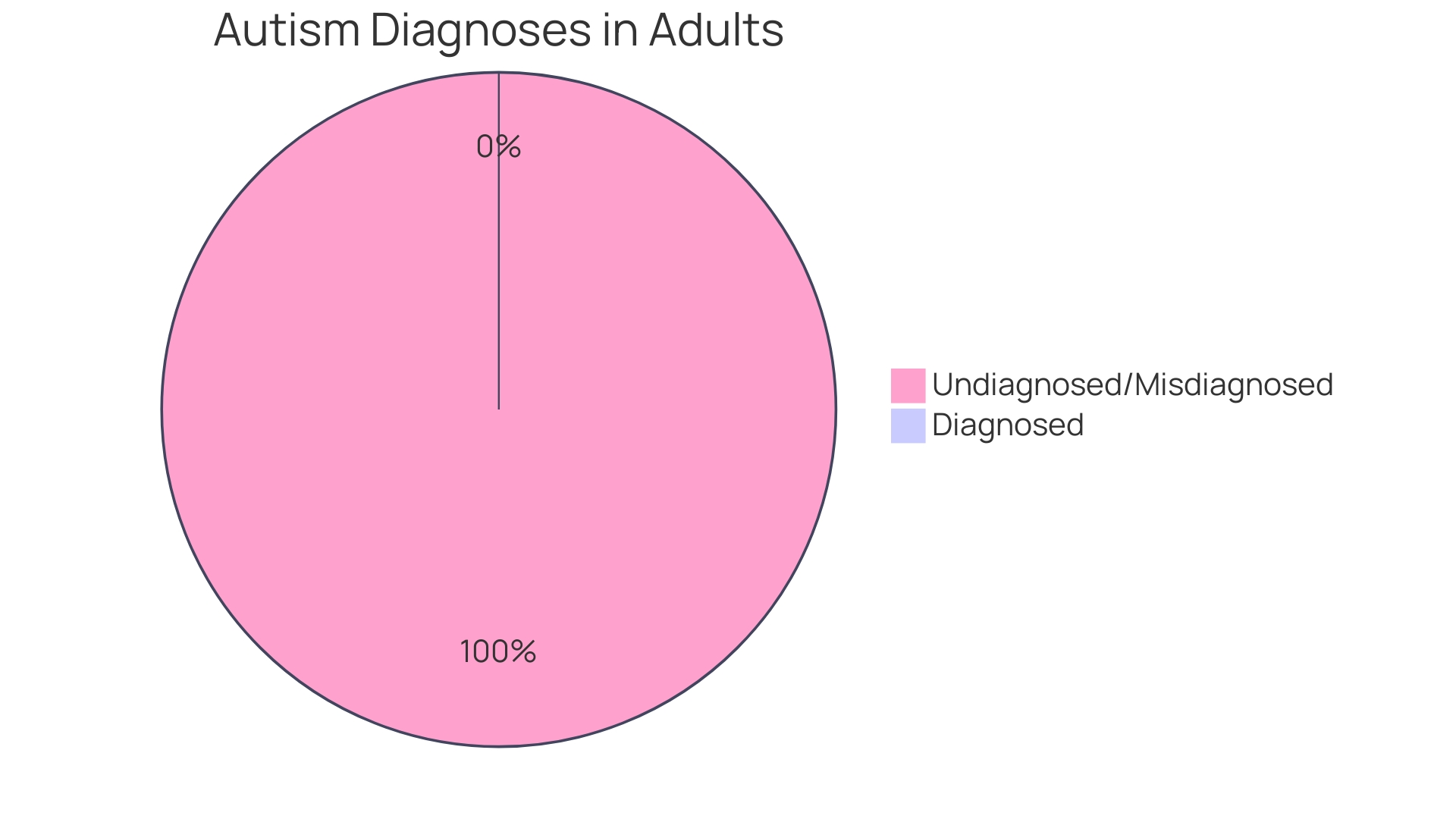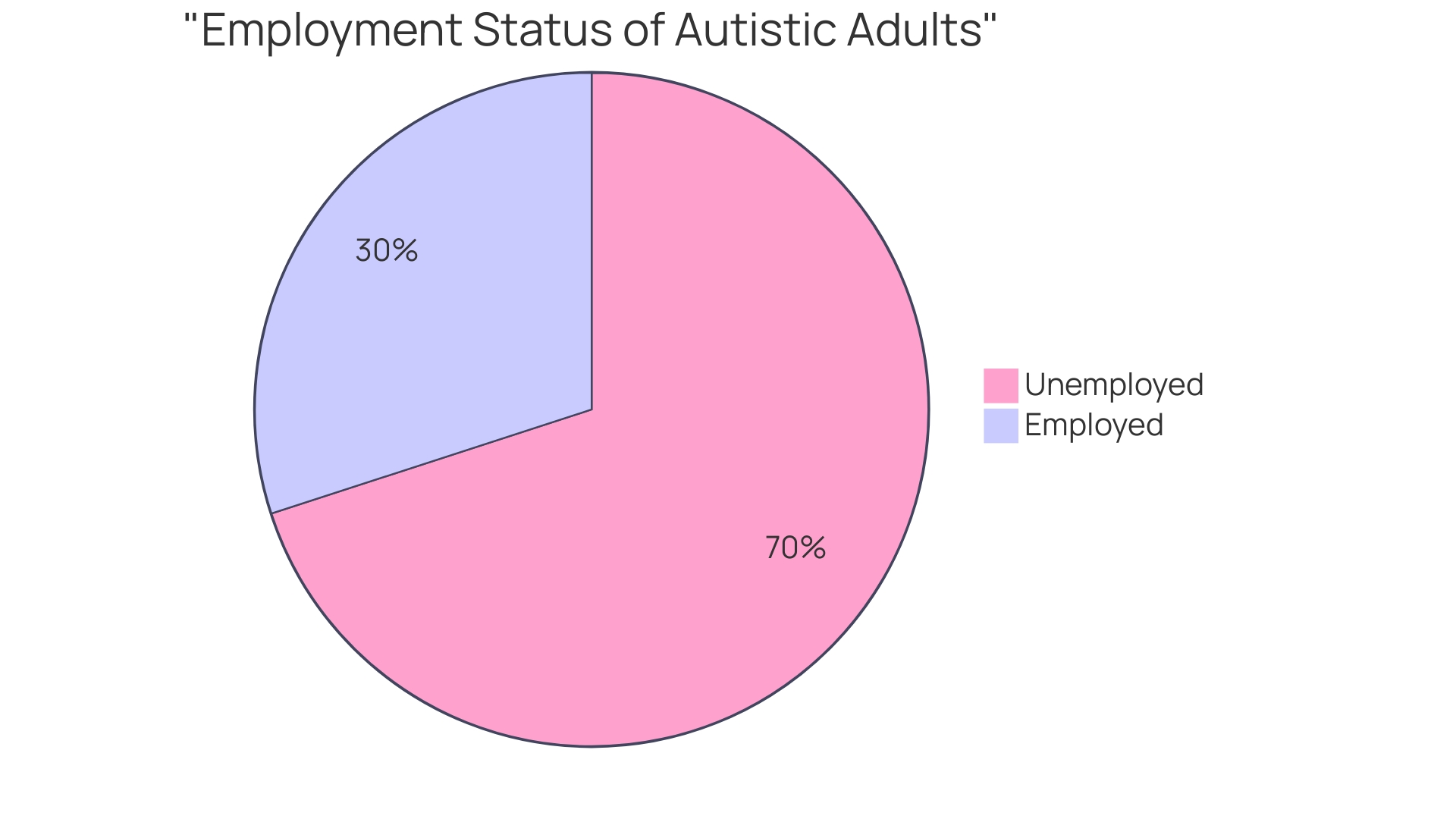Introduction
Autism spectrum disorder (ASD) is a condition that affects individuals throughout their lives, with distinct challenges in social communication and behavior. While awareness and recognition of autism in adults have improved, many still remain undiagnosed or misdiagnosed.
In this article, we explore the signs of autism in adult women and men, the challenges in diagnosing autism in adults, the importance of early recognition and intervention, strategies for managing symptoms and building relationships, resources and services available for adults with autism, and the need for embracing neurodiversity to improve their quality of life. By understanding and addressing the unique needs of autistic adults, we can foster a more inclusive society that supports their well-being and empowers them to thrive.
Understanding Adult Autism: Debunking Stereotypes
Autism spectrum disorder (ASD) is a multifaceted condition that persists into adulthood, affecting 1 in 45 adults in the U.S. Traditionally underrecognized in this demographic, ASD manifests through distinct challenges in social communication and the presence of restricted and repetitive behaviors. With heightened public health initiatives, screening procedures, and advocacy, recognition of autism in adults is improving, yet many remain undiagnosed or misdiagnosed.
For those who have navigated life's complexities unaware of their autistic traits, identifying the signs of ASD is a crucial step toward self-understanding and accessing support. Research, such as that conducted by Desiree Jones and Dr. Noah Sasson at the School of Behavioral and Brain Sciences, is dismantling harmful stereotypes, revealing that autistic individuals, irrespective of their support needs, often desire social connections. Acknowledging the diversity within the autism community is key to fostering an inclusive society that values and supports all individuals on the spectrum.
Signs of Autism in Adult Women: Social Difficulties and Camouflaging
Autism spectrum disorder is a developmental condition that individuals are born with, yet its manifestations, particularly in women, can be subtle and frequently misunderstood. Adult women with autism may experience a lifetime of social challenges, often struggling to interpret and react to social cues.
This can lead to a reliance on mental 'checklists' to navigate social interactions, where responses are learned and rehearsed rather than instinctive. The pressure to conform to societal expectations can lead to a phenomenon known as camouflaging, where women mask their autistic traits to blend in.
Recognizing these signs is vital, not only to support neurodivergent individuals but also to celebrate the diversity they bring to our communities. As someone who has navigated the journey of late diagnosis, I've seen firsthand the transformative power of understanding one's neurodiversity. It can be a gateway to self-acceptance and a more authentic life, despite the challenges of overcoming internalized stigma and the fear of societal judgment.
Autism in Adult Men: Common Symptoms and Misdiagnosis
Autism spectrum disorder (ASD) doesn't discriminate by gender, yet historical data has shown a skew towards diagnosing boys in childhood, overshadowing the reality that adult women are also affected. Researchers are now shedding light on the gender disparities in autism diagnosis, pointing out that women and girls have often been underdiagnosed, misdiagnosed, or diagnosed later in life compared to their male counterparts. This is due in part to the fact that autism characteristics can manifest differently in females, with variations in social development being a key differentiator.
Acknowledging these gender-based differences is crucial for ensuring that women receive the tailored support they need. Experts suggest that the diagnostic criteria for autism may require gender-specific adjustments to accurately identify autistic traits in women. As early diagnosis and intervention are pivotal for positive developmental outcomes in children, and as adults benefit significantly from appropriate support, it is essential to recognize and understand the unique signs of autism in adult women.
Autism Spectrum Disorder in Adults: Diagnosis and Support
Understanding autism in adults requires recognizing the nuance in presentation and the possibility of 'masking,' where individuals consciously or unconsciously conceal their symptoms to fit into social norms. Self-diagnosis is a respected route within the autistic and neurodivergent community, especially given the challenges and often inconclusive results of medical testing.
For many, an official diagnosis may not be pivotal for their success and well-being. In fact, statistics show that 1 in 45 adults in the U.S. are diagnosed with ASD, yet numerous individuals may remain undiagnosed or misdiagnosed.
The key indicators of autism, such as difficulties in social communication and repetitive behaviors, manifest in adults just as they do in children. Recognizing these signs can be the first step towards self-awareness and seeking appropriate support. The Spectrum magazine, created by and for the autistic community, serves as a testament to the importance of self-advocacy and the collective effort to build a society attuned to the needs of autistic individuals.

Challenges in Diagnosing Autism in Adults: Milder Symptoms and Masking
Autism diagnosis in adults is often a complex journey, not least because symptoms can be subtler and many individuals develop coping strategies to mask their difficulties. Yet, it's important to clarify that an official diagnosis is not always necessary to identify as autistic. The neurodivergent community acknowledges self-diagnosis as valid, especially considering the limitations and sometimes inconclusive results of medical testing.
For those who do not require a formal diagnosis for personal support, the journey to obtain one may not be a cost-effective or necessary path. However, some choose this route for clarity and to access certain forms of assistance. In the United States, it's estimated that 1 in 45 adults are diagnosed with autism spectrum disorder (ASD), suggesting that a significant number of adults could be undiagnosed or misdiagnosed.
With increased awareness and advocacy, more adults are recognizing potential signs of autism later in life. Understanding the common symptoms, which include social communication challenges and restricted, repetitive behaviors, is crucial for identifying undiagnosed ASD in adults. The term 'camouflaging' is frequently used in discussions about autism, particularly concerning how individuals may mask their symptoms.
It's essential that when discussing camouflaging, clear definitions are provided. As one expert expressed, a narrow and specific definition is necessary to avoid confusion and to ensure that studies measure and operationalize the concept effectively. This precision is vital for understanding the diverse experiences of autistic adults and the varied ways in which they navigate their social environments.
The Importance of Early Recognition and Intervention
Early recognition and intervention are crucial in supporting individuals with autism. By identifying the signs of autism in adults early on, we can provide appropriate interventions and support to enhance their quality of life. It is important for individuals, families, and professionals to be aware of the importance of early recognition and intervention in improving outcomes for adults with autism.
Strategies for Building Relationships and Managing Symptoms
With a staggering 1 in 45 adults in the United States diagnosed with autism spectrum disorder (ASD), it's clear that autism touches many lives. Yet, for every diagnosis, there are numerous adults who have lived without one, possibly misdiagnosed or unrecognized. These individuals have navigated life's complexities, often without understanding why they face certain challenges.
Among the key indicators of autism are social communication difficulties and patterns of behavior that are both restricted and repetitive. These traits persist into adulthood, affecting relationships and daily functioning. Recognizing these signs is paramount for adults who may not have been diagnosed as children.
As awareness grows and screening becomes more prevalent, the opportunity for these adults to gain insights into their experiences and to find strategies for managing symptoms is expanding. Understanding the signs of autism is a critical step in seeking the right support and resources to lead a fulfilling life. Armed with this knowledge, adults with ASD can approach their unique challenges with confidence and the backing of a more informed and supportive community.
Resources and Services for Adults with Autism
Understanding the unique needs of autistic adults is crucial in providing them with the right kind of support to lead fulfilling lives. With an estimated 1 in 70 people being autistic, there's a significant number of individuals who could benefit from tailored resources and services.
In the UK alone, there are around 680,000 working-age people who identify as autistic, many of whom are eager to engage in meaningful employment. However, they face considerable challenges, as only about 30% of working-age autistic adults are employed, compared to 50% of all disabled individuals and 80% of non-disabled people.
Moreover, autistic adults encounter a substantial pay gap, earning on average a third less than their non-disabled counterparts. This disparity underscores the importance of vocational training and employment opportunities specifically designed to accommodate the unique talents and needs of autistic adults. By increasing awareness and facilitating access to specialized support groups, therapy services, and vocational programs, we can create an environment where autistic adults are not just capable of thriving but are also recognized and valued for their contributions to the workforce.

Embracing Neurodiversity and Improving Quality of Life
To truly support the flourishing of autistic adults, it is crucial to focus not only on their individual abilities but also on the context of their daily lives. Research has shown that a significant disconnect exists between the controlled environment of lab studies and the real-world experiences of autistic individuals.
A meta-analysis revealed that the moderate effect sizes found in lab settings contrast sharply with the substantial real-world challenges reported by autistic individuals, highlighting the need for research that is deeply rooted in authentic, everyday contexts. Moreover, during the COVID-19 pandemic, autistic individuals expressed a profound sense of loss over their disrupted routines, which are vital for their well-being.
This underscores the importance of recognizing and valuing the seemingly mundane yet essential aspects of life that contribute to autistic well-being. By embracing a contextual understanding of autism and moving away from a strictly medical model that locates the 'fault' within the individual, we can better address the core challenges faced by autistic adults. Incorporating the perspectives and preferences of the autistic community, such as the SCERTS® Model's focus on Social Communication, Emotional Regulation, and Transactional Support, is imperative for creating inclusive and supportive environments. Collaborative platforms like Embrace ASD and Spectrum Women exemplify the positive impact of involving autistic voices in shaping the narrative, ensuring that research, policies, and educational approaches are aligned with the actual needs and aspirations of the autistic community.
Conclusion
In conclusion, understanding and recognizing autism in adults is crucial for fostering an inclusive society. Many adults with autism remain undiagnosed or misunderstood, emphasizing the need for increased awareness. Autism manifests differently in women and men, with subtle signs often overlooked.
Gender-specific adjustments are necessary to accurately diagnose and support individuals. Early recognition and intervention enhance the quality of life for adults with autism. Providing appropriate support early on is vital.
Tailored resources and services are essential for meeting the unique needs of autistic adults. Vocational training and employment opportunities can address employment gaps and pay disparities. Embracing neurodiversity is key to improving the lives of autistic adults.
Understanding their experiences in everyday contexts helps address core challenges. By understanding and addressing the unique needs of autistic adults, we can foster a more inclusive society that supports their well-being. Together, let's create a world that values neurodiversity and empowers all individuals on the spectrum to thrive.




